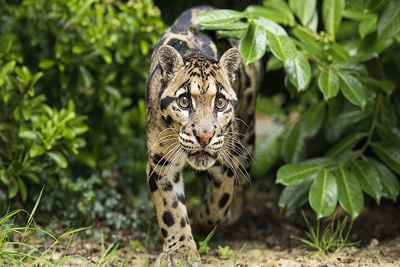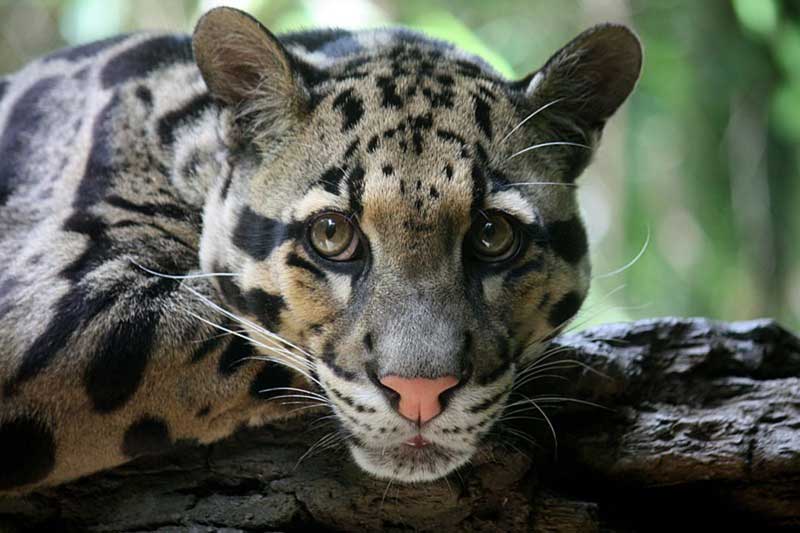
Although named Clouded Leopards for their cloud-like spots, the Clouded leopards are not directly related to normal leopards, but are considered a member of the Pantherinae family that also includes lions, tigers, jaguars, leopards, and snow leopards. However, while more closely related to big cats, the clouded leopard is frequently described as bridging the gap between big and small cats, largely due to its smaller stature. They are the smallest of the big cats, secretive and rare in the wild and prefer to remain alone and hidden from view. Recently, it has been estimated that the clouded leopard is the first cat that branched from other members of the Pantherinae family from around 9 to 6 million years ago, making them the earliest feline species in the modern cat world.

The Clouded Leopards prefer to live in lowland tropical rainforests, but they can also be found in dry woodlands and secondary forests. They have been spotted in the foothills of the Himalayas at an elevation of 9,000 feet (2,743 m) and are also reported to live in mangrove swamps in Borneo. However, historically, their range covered most of Southeast Asia and southern China through the Himalayan foothills in Nepal, Bhutan, India, Bangladesh to Myanmar, Thailand, Indonesia and Borneo.
While their total population is suspected to be fewer than 10,000 mature individuals and is locally extinct in Singapore, Taiwan and possibly Vietnam, mostly due to deforestation and illegal poaching, their population is probably healthiest in Borneo, due to the absence of tigers and leopards.

The Clouded Leopards, larger than small cats and smaller than the large cats, are 4 to 6 feet (1.2 to1.8 m) long, almost half of which is the tail and usually stand 10 to 16 inches tall. It use its long tail for balancing when moving in trees and is able to climb down vertical tree trunks head first, like a squirrel. While the larger males weigh up to around 23 kg (50 pounds), the female counterparts are significantly smaller, usually weighing around 11 to 21 kg (25 to 35 pounds). Their greyish brown coat, spotted on the body with large, dark cloud-like patches partly edged with black, helps them to camouflage in the dappled light of their normal forest habitat. Apart from the dark blotches, partly fused or broken-up stripes run from the corner of their eyes over the cheek, from the corner of the mouth to the neck, and along the nape to the shoulders.
It also has black spots on the head and the ears are black. While the underparts and legs are spotted, the tail is marked by large, irregular, paired spots. Its stout hind legs are longer than its front legs, which help for increased jumping and leaping capabilities and its large paws are armed with sharp claws and specialized padding that conforms to the shape of the branch. Its irises are brownish yellow to greyish green and the pupils never get fully round like that of any other big cat and contract into vertical slits. However, perhaps the most distinctive feature of the clouded leopard is its exceptionally long canine teeth, the upper being about three times as long as the basal width of the socket. It cannot roar like lions and tigers, but can purr like the small cats and also have a low, moaning roar, a low snuffling sound as part of their calling. Their vocalisations include a short high-pitched meow call, a loud crying call, when trying to locate a partner and growl with a low-pitched sound to express anger and a hiss with exposed teeth and wrinkled nose.

The clouded leopard is a secretive and nocturnal animal that uses trees as daytime rest sites and spends the night on the ground for hunting. Like all wild cats, they are carnivores and are thought to hunt a variety of prey, which include wild pigs, deer, gibbons and macaques, squirrels, slow lorises, rodents and even birds. Although a relatively small predator, a clouded leopard can take down sizeable prey because of its strong legs, large canines and extreme gape, with the ability to open the mouth to about 100 degrees. After feeding on a kill, it usually retreats into trees to digest and rest lazily.

Like the other big cats, the clouded leopard is known to be a solitary cat, unless associated with a mate while breeding or accompanied by cubs. They become sexually mature aroun the age of two years and mating may occur in any month, but in captivity most breeding occurs between December and March. The pair mates multiple times over several days, but not without incidences of severe aggression between the pair during mating, when the male grasps the female by the neck and often bites aggressively.
As adult males are about twice the size of females, the chance of injury to the female during mating is very high, which sometimes ends even in the death of the female. This strange behaviour of the mating pair made the clouded leopards one of the most difficult cats to breed in zoos and conservation centres.

After a gestation period of 90 to 95 days, the female gives birth to a litter of one to five, mostly three cubs. While the cubs are born with closed eyes, the male does not involve in raising the cubs. Their eyes open after about 10 days, become fully weaned at around three months of age and become independent at about 10 months of age. Although the average life span of the clouded leopard is 12 to 15 years, they may live up to 17 years in human care.